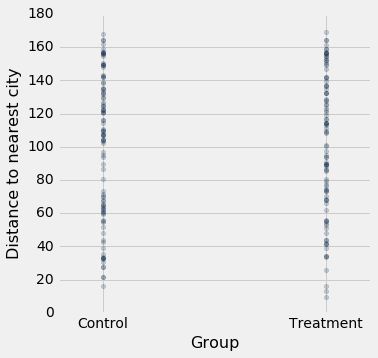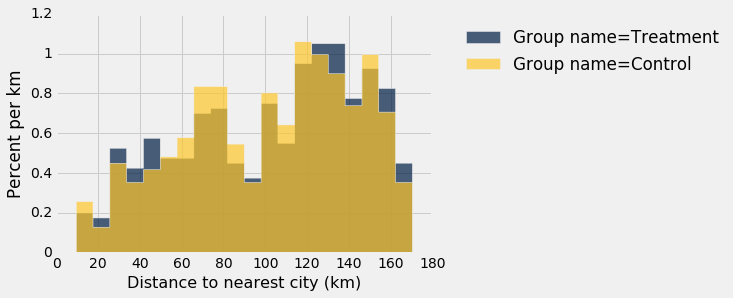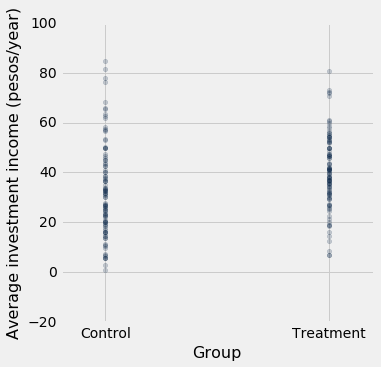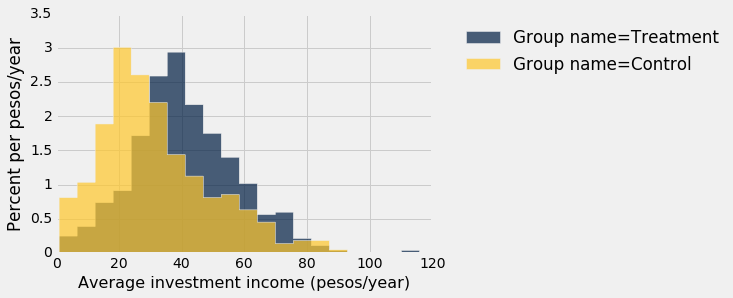Car Efficiency
Welfare subsidies in Mexico¶
In rural Mexican villages in the 1990’s, children in poor families were often not enrolled in school. One of the reasons was that the older children could go to work and thus help support the family. Santiago Levy , a minister in Mexican Ministry of Finance, set out to investigate whether welfare programs could be used to increase school enrollment and improve health conditions. He conducted an RCT on a set of villages, selecting some of them at random to receive a new welfare program called PROGRESA. The program gave money to poor families if their children went to school regularly and the family used preventive health care. More money was given if the children were in secondary school than in primary school, to compensate for the children’s lost wages, and more money was given for girls attending school than for boys. The remaining villages did not get this treatment, and formed the control group.
Because of the randomization, there were no confounding factors; all possible confounding factors are approximately the same for the treatment and control groups. The following scatter plot, for example, shows the distance to the nearest city (a potentially-important factor in education, health, and economic growth) in a small sample of the villages in the treatment and control groups. There is no distinguishable pattern of differences.
investments = Table.read_table("progresa_sample.csv")
investments.scatter('Group', "Distance to nearest city", alpha=.2)
# We relabel the axes for clarity:
plots.xticks([0, 1], ['Control', 'Treatment']);
Histograms: A better way to visualize and compare sets of numbers¶
Actually, this scatter plot is not so helpful for seeing the difference in the pattern of distances. You have to read it very carefully to see where the dots are concentrated.
A better visualization for data like this is a histogram, which directly shows the concentration of numbers.
The plot below shows two overlapping histograms, one for the treatment group and one for the control. Each histogram is like one of the columns of dots in the scatter plot, but flipped 90 degress onto its side, and with bars to show the concentration of dots. Since the blue and gold bars mostly overlap, there isn't much difference in the pattern of distances.
investments_full = Table.read_table("progresa.csv")
investments_full.hist('Distance to nearest city', group='Group name', bins=20, unit="km")
plots.xlabel("Distance to nearest city (km)");
The lack of confounding factors facilitated by randomization made it possible to establish that PROGRESA caused an increase in school enrollment.
An outcome of the experiment: Investment income¶
PROGRESA provides an opportunity for us to study the other effects of giving money to poor families. For example, a family receiving money for school and health care might spend some of the money on other investments, like livestock or land improvements. In later years, families would reap benefits from these investments in the form of investment income.
A group of Harvard researchers therefore investigated the effect of PROGRESA benefits on families' later investment income.
Below is a scatter plot and matching histogram for investment income. The scatter plot is again difficult to read, but the histogram tells a clear story. The blue bars are generally further to the right than the yellow bars. That means villages in the treatment group tended to have higher investment income than villages in the control group.
investments.scatter('Group', "Average investment income (pesos/year)", alpha=.2)
# We relabel the axes for clarity:
plots.xticks([0, 1], ['Control', 'Treatment']);
investments_full.hist("Average investment income (pesos/year)", group="Group name", unit="pesos/year", bins=20)
plots.xlabel("Average investment income (pesos/year)");
Again, since randomization ensures that confounding factors are approximately equal across the two groups, we can safely say that the higher investment income was caused by PROGRESA.
PROGRESA was later adopted nationwide in Mexico under the name Oportunidades.



